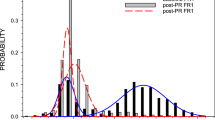Abstract
The effects of pipradrol (5–15 mg/kg), methylphenidate (5–15 mg/kg), d-amphetamine (0.5–3.0 mg/kg), and nomifensine (5–15 mg/kg) on the acquisition of responding with conditioned reinforcement (CR) were examined. In preliminary training (phase 1), a panel-push was required for water-deprived rats to obtain access to a water-dipper. The presentation of the dipper occurred at variable intervals, independently of responding, and was preceded by a light stimulus. In phase 2, no water was available and presentation of light and empty dipper (CR) was contingent upon pressing one of two levers present (CR lever), according to a variable-ratio 2 schedule. Pressing the other lever had no effect (NCR lever). In Experiment I, pipradrol produced a dose-dependent increase in responding on the CR lever, but a dose-dependent decrease on the NCR lever. Methylphenidate and d-amphetamine produced inconsistent results, and nomifensine produced a general reduction in responding. The stimulation of responding by pipradrol transferred to the undrugged state, but previous experience with pipradrol outside the experimental setting did not increase responding during control sessions. Experiment II showed that the effects of repeated doses of pipradrol changed over sessions. Experiment III showed that 15 mg/kg pipradrol did not increase responding for the light and dipper stimuli when these had not previously been paired with water. The results suggest that pipradrol enhances the effects of conditioned reinforcers, and are discussed in terms of the other behavioral effects of ‘psychomotor stimulant’ drugs.
Similar content being viewed by others
References
Bauer, R. H., Duncan, N. C.: Twenty-four hour proactive facilitation of avoidance and discrimination learning in rats by d-amphetamine. J. Comp. Physiol. Psychol. 77, 521–527 (1971)
Braestrup, C., Scheel-Krüger, J.: Methylphenidate-like effects of the new anti-depressant drug, nomifensine (HOE 984). Eur. J. Pharmacol. 38, 305–312 (1976)
Dews, P. B.: Studies on behavior. II. The effects of pentobarbital, methamphetamine and scopolamine on performance in pigeons involving discriminations. J. Pharmacol. Exp. Ther. 115, 380–389 (1955)
Dews, P. B.: Studies on behavior. IV. Stimulant actions of methamphetamine. J. Pharmacol. Exp. Ther. 122, 137–147 (1958)
Faidherbe, J., Richelle, M., Schlag, J.: Nonconsumption of the reinforcer under drug action. J. Exp. Anal. Behav. 5, 521–524 (1962)
Glick, S. D.: Facilitation or impairment of learning by d-amphetamine as a function of stimuli. Psychopharmacologia (Berl.) 21, 353–360 (1971)
Glow, P. H., Russell, A.: Effects of d-amphetamine, amylobarbitone sodium and their mixture on sensory contingent bar pressing behavior in the rat. Psychopharmacologia (Berl.) 31, 239–251 (1973)
Gray, J. A.: The effect of pipradrol hydrochloride and sodium amylobarbitone on operant responding in the discriminant situation. Psychopharmacologia (Berl.) 6, 417–434 (1964)
Hill, R. T.: A behavioral analysis of the psychomotor stimulant effect of a drug: the interaction of pipradrol with conditioned reinforcers. Ph. D. dissertation, Columbia University, U.S.A. (1967)
Hill, R. T.: Facilitation of conditioned reinforcement as a mechanism of psychomotor stimulation. In: Amphetamines and related compounds, E. Costa and S. Garattini, eds., pp. 781–795. New York: Raven 1970
Hill, R. T.: Animal models of the euphorigenic action of amphetamine-like psychomotor stimulant drugs. Paper presented at the annual meeting of the American Psychological Association (Div. 28) Honolulu, Hawaii, 1972
Keehn, J. D.: Maintenance of behavior by secondary reinforcement. Acta Psychologia 25, 314–333 (1966)
Kelleher, R. T., Gollub, L. R.: A review of positive conditioned reinforcement. J. Exp. Anal. Behav. 5, 543–597 (1962)
Kelleher, R. T., Morse, W. H.: Determinants of the specificity of the behavioral effects of drugs. Ergeb. Physiol. 60, 1–56 (1968)
Kiernan, C. C.: Modification of the effects of d-amphetamine sulphate by past experience in the hooded rat. Psychopharmacologia (Berl.) 8, 23–31 (1965)
Laties, V. G.: The role of discriminative stimuli in modulating drug action. Fed. Proc. 34, 1880–1888 (1975)
Lyon, M., Robbins, T. W.: The action of central nervous system stimulant drugs: a general theory concerning amphetamine effects. In: Current developments in psychopharmacology, W. B. Essman and L. Valzelli, eds., vol. 2, pp. 79–163. New York: Spectrum 1975
Mackintosh, N. J.: The psychology of animal learning. London: Academic Press 1974
Randrup, A., Munkvad, I.: Stereotyped behavior produced by amphetamine in several animal species and man. Psychopharmacologia (Berl.) 11, 300–310 (1967)
Robbins, T. W.: The potentiation of conditioned reinforcement by psychomotor stimulant drugs: a test of Hill's hypothesis. Psychopharmacologia (Berl.) 45, 103–114 (1975)
Robbins, T. W.: Relationship between reward-enhancing and stereotypical effects of psychomotor stimulant drugs. Nature 264, 57–59 (1976)
Scheel-Krüger, J.: Comparative studies of various amphetamine analogues demonstrating different interactions with the metabolism of the catecholamines in the brain. Eur. J. Pharmacol. 14, 47–59 (1971)
Stretch, R., Gerber, G. J.: Drug-induced reinstatement of amphetamine self-administration behavior in monkeys. Can. J. Psychol. 27, 168–177 (1973)
Weissman, A.: Differential drug effects upon a three-ply multiple schedule of reinforcement. J. Exp. Anal. Behav. 2, 271–287 (1959)
Winer, B. J.: Statistical principles in experimental design, 2nd ed., New York: McGraw-Hill 1971
Author information
Authors and Affiliations
Rights and permissions
About this article
Cite this article
Robbins, T.W. The acquisition of responding with conditioned reinforcement: Effects of pipradrol, methylphenidate, d-amphetamine, and nomifensine. Psychopharmacology 58, 79–87 (1978). https://doi.org/10.1007/BF00426794
Received:
Issue Date:
DOI: https://doi.org/10.1007/BF00426794




